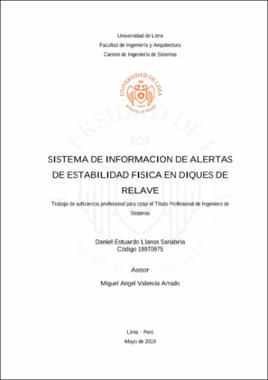| dc.contributor.advisor | Valencia Amado, Miguel Ángel | |
| dc.contributor.author | Llanos Sanabria, Daniel Estuardo | |
| dc.date.accessioned | 2021-01-22T00:02:55Z | |
| dc.date.available | 2021-01-22T00:02:55Z | |
| dc.date.issued | 2019 | |
| dc.identifier.citation | Llanos Sanabria, D. E. (2019). Sistema de información de alertas de estabilidad física en diques de relave [Trabajo de suficiencia profesional para optar el Título Profesional de Ingeniero de Sistemas, Universidad de Lima]. Repositorio Institucional de la Universidad de Lima. https://hdl.handle.net/20.500.12724/12352 | es_PE |
| dc.identifier.uri | https://hdl.handle.net/20.500.12724/12352 | |
| dc.description.abstract | Debido a la problemática actual donde se ven afectados directamente los recursos naturales por la contaminación de grandes extensiones de suelos y ríos, impactando el medioambiente, dicha contaminación son ocasionadas por las fallas en la estabilidad física de los diques de relave. Para ello se plantea el desarrollo de un sistema de alertas de la estabilidad física de los diques, con la finalidad de minimizar los riesgos y evitar que ocurran estos derramamientos de relave, por tanto, se abordara el caso en base a las entrevistas y a los informes del Ministerio de Energía y Minas (MINEM).
Luego del análisis de las entrevistas y de los informes proporcionados por elMinisterio de Energía y Minas, se identificó la necesidad de automatizar el registro de las mediciones de las variables de humedad e inclinación de los diques de relave, por lo que el análisis se realizará principalmente sobre estas dos variables que son fundamentales para mantener la estabilidad de los diques, ya que si estas variables no son controladas se tendría un riesgo potencial de deslizamientos en los dique de relaves.
El objetivo de este proyecto consiste en automatizar la recolección de la data a través de los sensores digitales de humedad e inclinación instalados en el dique de relave para luego enviar esta data hacia los servicios de computación en la nube (Computing Cloud Services). Por medio de una conexión a Internet donde se podrá acceder a los recursos computacionales donde estarán desplegados los servidores web y base de datos,
para la implementación del servicio se enfoca en la infraestructura como servicio de “Infraestructure as a Service” (IaaS), posteriormente con el uso de aprendizaje automático (Machine Learning) como medio de innovación se podrá interpretar esta data y generar posibles escenarios de predictibilidad, para evitar fallas de estabilidad física.
Esta propuesta busca dar solución como medida de prevención de colapsos de diques de relave, con esto se mitigaría los desastres medioambientales, y pérdidas humanas de las comunidades donde se desarrolla la actividad minera. | es_PE |
| dc.description.abstract | Due to the current problems where natural resources are directly affected by contamination of large areas of soil and rivers, impacting the environment, said contamination is caused by failures in the physical stability of the tailings dikes. For this, the development of an alert system for the physical stability of the levees is proposed, in order to minimize the risks and prevent these tailings spills from occurring, therefore the case will be addressed based on the interviews and reports from the Ministry of Energy
and Mines (MEM).
After the analysis of the interviews and the reports provided by the Ministry of Energy and Mines, the need to automate the recording of the measurements of the variables of humidity and inclination of the tailings dikes was identified, so the analysis will be carried out mainly on these two variables that are essential to maintain the stability of the dams, since if these variables are not controlled there would be a potential risk of landslides in the tailings dam.
The objective of this project is to automate the data collection through the digital humidity and inclination sensors installed in the tailings dam and then send this data to the computing services in the cloud (Computing Cloud Services). Through an Internet connection where you can access the computational resources where the web servers and databases will be deployed, for the implementation of the service it focuses on the infrastructure as a service of “Infrastructure as a Service” (IaaS), later With the use of machine learning (Machine Learning) as a means of innovation, it will be possible to
interpret this data and generate possible predictability scenarios, to avoid physical stability failures.
This proposal seeks to provide a solution as a measure to prevent the collapse of tailings dams, thereby mitigating environmental disasters and human losses in the
communities where mining activities take place. | es_PE |
| dc.format | application/pdf | es_PE |
| dc.language.iso | spa | es_PE |
| dc.publisher | Universidad de Lima | es_PE |
| dc.rights | info:eu-repo/semantics/openAccess | |
| dc.rights.uri | http://creativecommons.org/licenses/by/4.0 | * |
| dc.source | Repositorio Institucional - Ulima | es_PE |
| dc.source | Universidad de Lima | es_PE |
| dc.subject | Sistemas de información | es_PE |
| dc.subject | Computación en la nube | es_PE |
| dc.subject | Diques | es_PE |
| dc.subject | Relaves mineros | es_PE |
| dc.subject | Information systems | es_PE |
| dc.subject | Cloud computing | es_PE |
| dc.subject | Dikes (Engineering) | es_PE |
| dc.subject | Tailings (Metallurgy) | es_PE |
| dc.subject.classification | Ingeniería de sistemas / Sistemas de información | es_PE |
| dc.title | Sistema de información de alertas de estabilidad física en diques de relave | es_PE |
| dc.title.alternative | Physical stability alerts information system in tailings dams | es_PE |
| dc.type | info:eu-repo/semantics/bachelorThesis | |
| thesis.degree.discipline | Ingeniería de Sistemas | es_PE |
| thesis.degree.level | Titulo profesional | es_PE |
| thesis.degree.name | Ingeniero de sistemas | es_PE |
| dc.subject.ocde | https://purl.org/pe-repo/ocde/ford#2.02.04 | |
| renati.level | http://purl.org/pe-repo/renati/level#tituloProfesional | |
| renati.type | https://purl.org/pe-repo/renati/type#trabajoDeSuficienciaProfesional | |



